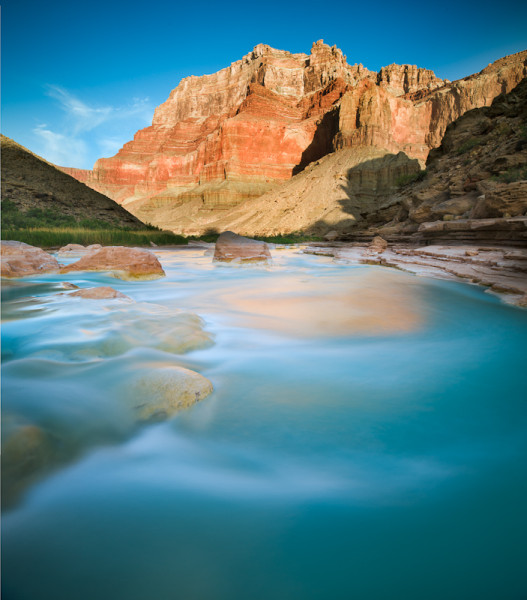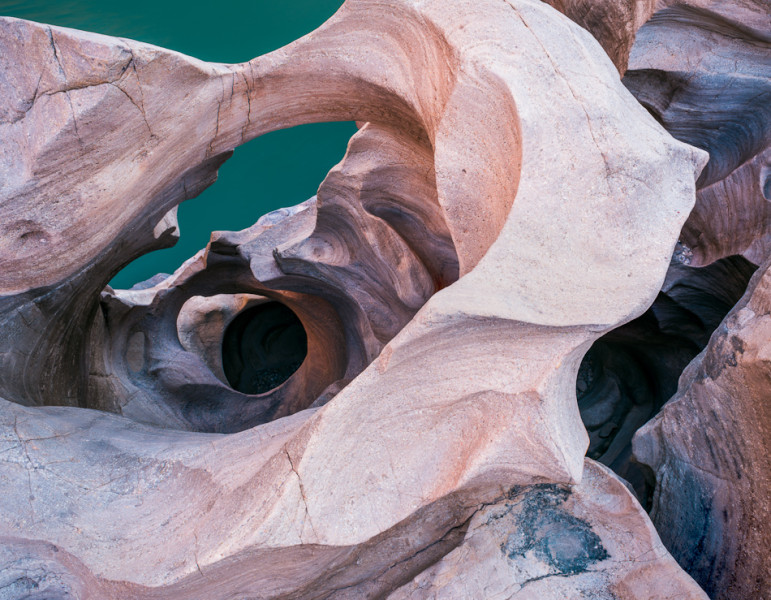On a Grand Canyon raft trip, you learn to expect the unexpected, and this day was no different. The casual hike we’d planned – to photograph the elegantly eroded limestone watercourses of a side canyon called Matkatimiba – seemed to be a bust. A recent flash flood had deposited a dam of gravely debris at the mouth of the canyon, forming a forty-foot wall-to-wall pool of unknown depth. While we pondered the feasibility of getting across, we seized the opportunity to photograph the canyon walls mirrored in the pool. Then, we went for it. Stashing our gear in dry bags, the twelve of us helped one another wade, swim, or float across the pool. The shallowest route across was neck deep to me, and I’m 6’2”. We didn’t know what other surprises might await us around the next corner, but we were charged with a sense of adventure and the prospect of exploration and personal discovery, which are the key reasons I keep coming back.
Each year, about five million people travel by car, RV, motorcycle and tour bus to look down into this great chasm. My own teenage impression of my first visit to the South Rim – an impression I think must be common – was of a scene so vast and stark under the midday sun that depth and scale were difficult to grasp. This profoundly 3-D landscape seemed compressed into a two-dimensional panorama that had about as little emotional impact as a trite painted backdrop from a spaghetti western.
Through more recent photographic adventures, however, I’ve “seen the light” and havebeen moved deeply by the character of the place, which is anything but two-dimensional or trite. The Grand Canyon inspires authentic awe and wonder, invites the curious explorer, and rewards generously those who take the time to get to know it. The grandeur and sublime beauty of this complex landscape – carved out over seventy million years by the Colorado River and its tributaries as tectonic forces uplifted the Colorado Plateau in the river’s path – come alive at sunrise and sunset, beneath energetic August monsoon storms, or with a frosting of winter snow on the elevated rim. If the American Southwest is considered one of the most aesthetically inspiring landscapes on Earth, the Grand Canyon must be its crowning glory.
Most photographers who come to the Canyon – particularly for the first time – do so with the admirable goal of making photographs that attempt to capture its grandeur. The process of getting to know the canyon may include making personal attempts at iconic big-landscape compositions like those found at Toroweap or Maricopa Point. Those who take the time to explore, however, will find that one of the most wonderful things about Grand Canyon is that it might be best appreciated as a majestic sum of smaller, more intimate parts. It hides away real treasures within its folds and layers, just waiting to be discovered.
River-polished Vishnu schist, 1.84 billion years old, forms elegant flutes, fins, and minarets. Watercourses carve sinuous channels and slots into the Muavlimestone layer. Offset faults in sandstone cliffs tell the tale of immense shearing forces. Tapeats sandstone cliffs drilled-through by the river are sculpted into arcing loops and curlicues. The turquoise waters of travertine springs tumble over white dikes of precipitated calcium carbonate. Rosy-pink Zoroaster granite intrusions, injected as magma under unimaginable pressure, fill faults in the dark schist. Stones of myriad colors ornament Grand Canyon beaches, often many miles downstream from the formations that spawned them. Sheltered grottoes of ferns and scarlet monkeyflower seem so perfectly arranged that you’d imagine elves were the landscape architects. The sound of your own breath echoes from the walls of serene slot canyons that bare the telltale signs of eons of terrifying flash floods. It’s enough for a lifetime of exploration, discovery, and artful photography.
As always, the trick to chasing the spirit of these places is in the light, and I let the light be my guide. The canyon photographer is fortunate – good light can be found all day long if you know where to look, and in some locations it may even be best in the middle of the day. The sweetest light down in the depths of the canyon is reflected illumination from the canyon walls. When direct sun strikes a wall, look just opposite for compositions bathed in the warm, gentle, reflected glow in the shade. It provides just enough modeling to bring out textures and provide a three-dimensional effect without creating harsh contrast.
Wet reflections along the Colorado River and its tributary creeks can also be a powerful tool. If a west-facing wall high on the canyon rim is catching sunset light, I’ll get low to the ground and seek out compositions that incorporate its orange reflection in water, on a smooth wet rock, or on in wet sand along the riverbank. This helps to establish a sense of place and a connection between the intimate design of the foreground and the grand landscape beyond. For reflections on the river or other moving water, shutter speed becomes critical to the mood of the image. The combination of a strong neutral density filter and a low ISO can force an exposure of several seconds, which has the effect of smoothing and simplifying the complex graphic texture of the water while increasing the definition and color of the reflection.

Multi-colored rock, beached miles downstream from the formation that spawned it. © 2009 Justin Black
A powerful contrast for all these warm-toned reflections is of course the blue skylight that often fills the shadows. It’s amazing how colors and contrasts change depending on whether the sky is clear blue, overcast, or full of smoke from a fire in the ponderosa pine forest on the plateau above. Since the color temperature of light sources in the canyon varies widely, I’ll often set my camera’s color balance to a fixed color temperature (like 5000 Kelvin, for example) to ensure that the auto white balance feature doesn’t cancel out color contrasts that I want to include in the final image. A polarizing filter is tool I regularly use in canyon photography, as it can be critical for controlling the balance of cool skylight to warm bounce light, as well as sheen on wet or polished surfaces.
Dark silhouettes can also be compelling subjects, and in the canyon there is no shortage of strong, clean, graphic shapes that can be photographed against brighter backgrounds. Completeness and simplicity of form helps us read the shape quickly and easily in the final photograph, giving the silhouette its graphic power. Look for camera positions that allow you to separate them cleanly, minimizing disruptions that break up the shape.
Speaking of finding the right camera position, one approach that I’ve found useful is to mentally “project” the camera in space, imagining the perspective and composition from a particular nearby position rather than actually moving to it to look. With practice, you can even select the right lens and make almost all of your set-up decisions before even looking through the camera, which can save a great deal of time and trouble.
For example, while visiting another side canyon with a recent raft-trip group, we encountered a constriction where a narrow tongue of water drops through a lovely limestone slot into a pool. Smoothly converging diagonals give the impression of twisted taffy, and light reflecting from high on the canyon walls lends a warm accent to the mostly cool light from the blue sky far above. It begs for a picture, but several challenges must be overcome. First, you have to wade into the chest-deep pool to get an unobstructed view of the composition. Second, the camera position I envisioned was a few feet above the water, making it necessary to carefully brace the tripod between the slick limestone walls using contortions that would make a yogi envious. Finally, there is nowhere to set down a camera bag within reach. So, before wading in I eliminated as many variables as possible: I chose the appropriate lens, made sure my camera was set up in advance for the shot, and preset my tripod legs as much as I could. After wedging myself awkwardly into a position above the pool where I could reach the viewfinder to compose and focus, I made the picture and offered my prepositioned tripod to my companions, bracing it while they made images of their own.
As we walked back to camp wet and happy, we all expressed our thanks to The Grand Canyon for sharing yet another little gem with us.


